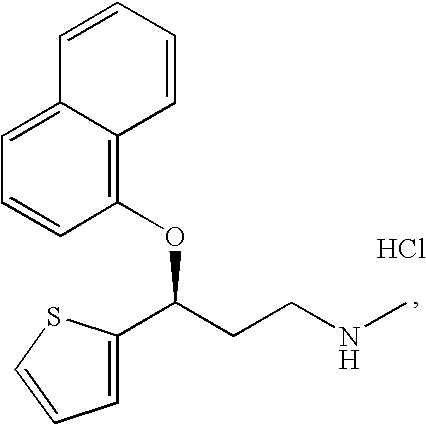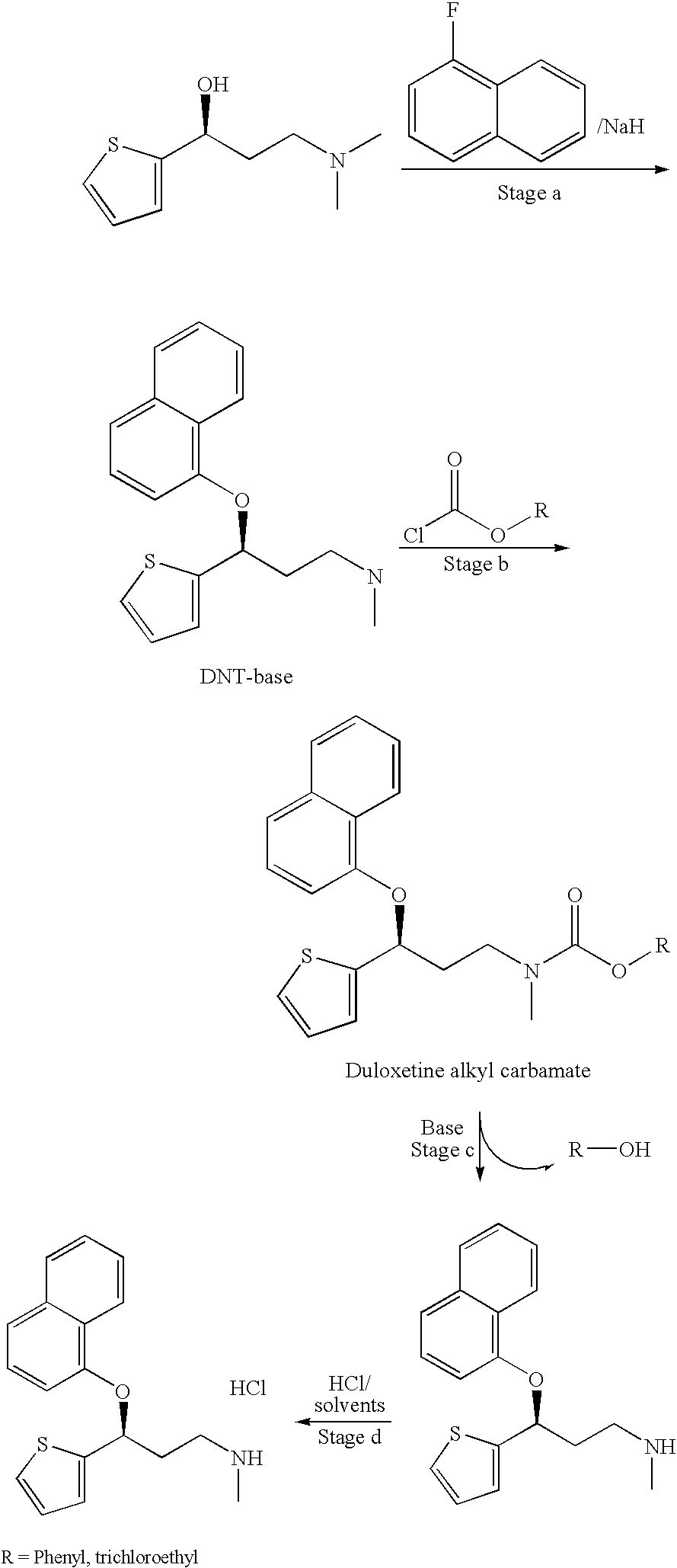Process for preparing pharmaceutically acceptable salts of duloxetine and intermediates thereof
- Summary
- Abstract
- Description
- Claims
- Application Information
AI Technical Summary
Benefits of technology
Problems solved by technology
Method used
Image
Examples
example 1
[0128] A 100 ml three necked flask, equipped with mechanical stirrer, thermometer, dean stark, and condenser, was charged with 5 g of (S)-DNT-base and 25 ml of toluene. The clear solution was heated, and an azeotropic distillation was performed for about 30 to about 60 minutes. After cooling to room temperature, 4.6 ml of ethyl chloroformate were added during over a period of 1 to 2 hours, and the reaction mixture was stirred at room temperature over night.
[0129] Diluted NH4OH was added to the reaction mixture, which was stirred for an additional 30 minutes. After phase separation, the organic phase was washed with water (3×20 ml), dried over Na2SO4, filtered, and concentrated to dryness to give 5.2 g of a brownish oil. (88% chemical yield).
example 2
[0130] A 100 ml three necked flask, equipped with mechanical stirrer, thermometer, dean stark, and condenser, was charged with 4 g of (S)-DNT-base and 20 ml of toluene. The clear solution was heated, and an azeotropic distillation was performed for about 30 to about 60 minutes. After cooling to 60° C., 3.7 ml of ethyl chloroformate were added over a period of 1 hour, and the reaction mixture was stirred at the same temperature for an additional 4.5 hours.
[0131] The resulting reaction mixture was washed with diluted HCl, water, diluted NH4OH, and water again. After phase separation, the organic solution was dried over Na2SO4, filtered, and concentrated to dryness to give 3.59 g of a brownish oil. (76% chemical yield)
example 3
[0132] A 100 ml three necked flask, equipped with mechanical stirrer, thermometer, dean stark, and condenser, was charged with 4 g (S)-DNT-base and 20 ml toluene. The clear solution was heated, and an azeotropic distillation was performed for about 30 to about 60 minutes. After cooling, 3.4 ml of diisopropyl ethyl amine were added, and the reaction mixture was heated to 60° C. Then, 3.7 ml of ethyl chloroformate were added over a period of 1 hour, and the reaction mixture stirred at the same temperature for an additional 1.5 hours.
[0133] The resulting reaction mixture was washed with diluted HCl and water, and diluted with NH4OH and water again. After phase separation, the organic solution was dried over Na2SO4, filtered, and concentrated to dryness to give 4.17 g of a brownish oil. (88% yield).
PUM
| Property | Measurement | Unit |
|---|---|---|
| Temperature | aaaaa | aaaaa |
| Temperature | aaaaa | aaaaa |
| Temperature | aaaaa | aaaaa |
Abstract
Description
Claims
Application Information
 Login to View More
Login to View More - R&D
- Intellectual Property
- Life Sciences
- Materials
- Tech Scout
- Unparalleled Data Quality
- Higher Quality Content
- 60% Fewer Hallucinations
Browse by: Latest US Patents, China's latest patents, Technical Efficacy Thesaurus, Application Domain, Technology Topic, Popular Technical Reports.
© 2025 PatSnap. All rights reserved.Legal|Privacy policy|Modern Slavery Act Transparency Statement|Sitemap|About US| Contact US: help@patsnap.com


